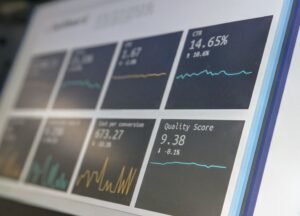The world of data is evolving rapidly, driving significant changes across industries. Businesses and professionals are increasingly leveraging data to make informed decisions, optimize operations, and deliver better customer experiences. From the rise of artificial intelligence to the expansion of edge computing, the data landscape is constantly being reshaped by new technologies and methodologies. In this blog, we explore some of the latest trends in the field of data, backed by facts and figures, and provide visual insights with charts and data.
1. The Surge of Artificial Intelligence (AI) and Machine Learning (ML)
AI and ML have transformed the way businesses utilize data. According to a study by Gartner, 70% of organizations will shift their focus from big data to smaller and more varied data sets that offer more valuable insights through AI by 2025.
Key Trends:
- AI-Driven Automation: Automating data processes and decision-making using AI models reduces human intervention.
- Natural Language Processing (NLP): NLP has enabled data analysis through unstructured text, powering chatbots, and virtual assistants.
- AutoML: Automated Machine Learning tools are democratizing data science, allowing non-experts to build complex models without coding skills.
AI Adoption Across Industries

2. Data Governance and Compliance Are Now More Critical Than Ever
Data privacy regulations like GDPR and CCPA have placed a renewed emphasis on data governance. Organizations are now required to manage data responsibly, protect consumer privacy, and comply with an increasing number of laws. By 2023, 65% of the world’s population will have its personal data covered by modern privacy regulations.
Key Trends:
- Data Stewardship: Organizations are appointing data stewards to ensure that data is handled securely and ethically.
- Data Governance Frameworks: Companies are adopting comprehensive governance frameworks to maintain compliance.
- Data Privacy as a Priority: Companies are prioritizing privacy by design in their data architecture.
Increasing Data Governance Investments

3. Rise of DataOps for Better Collaboration and Efficiency
DataOps, a set of practices to improve collaboration and automation of data workflows, is becoming crucial for managing and processing vast amounts of data. It brings together data engineers, analysts, and scientists to streamline the lifecycle of data analytics, from ingestion to insight generation.
Key Trends:
- Improved Data Quality: DataOps ensures continuous testing and monitoring to enhance data quality.
- Collaboration Between Teams: Cross-functional collaboration improves with standardized data processes.
- Faster Time to Insights: Automated data pipelines and real-time analytics result in quicker decision-making.
Adoption of DataOps Practices

Here are some top companies known for adopting and promoting DataOps practices:
- IBM
- Google Cloud
- Microsoft Azure
- Amazon Web Services (AWS)
- Dell Technologies
- Snowflake
- Cloudera
- Databricks
- DataKitchen
- StreamSets
These companies have implemented DataOps frameworks to streamline data processing, improve collaboration across teams, and automate data workflows, driving faster insights and innovation.
4. Cloud Data Platforms and the Emergence of Multi-Cloud Strategies
Cloud-based data storage and processing have become the backbone of modern data infrastructures. With cloud adoption rates at an all-time high, organizations are increasingly embracing multi-cloud strategies to enhance flexibility and avoid vendor lock-in.
Key Trends:
- Hybrid Cloud: Many businesses are opting for hybrid cloud environments to integrate on-premises infrastructure with cloud services.
- Multi-Cloud: Organizations are diversifying their cloud vendors to leverage the strengths of different platforms.
- Serverless Architecture: Serverless technologies are gaining popularity due to their cost-effectiveness and scalability.
Top Cloud Data Platforms Supporting Multi-Cloud
Google BigQuery

Amazon Redshift
Amazon Redshift offers integrations with other cloud platforms and has data-sharing capabilities that facilitate multi-cloud deployments, making it possible to scale analytics across environments.

Microsoft Azure Synapse Analytics
Azure Synapse Analytics provides powerful data integration, big data, and analytics services, and has built-in connectors for multi-cloud environments, especially with hybrid setups.

Cloudera Data Platform (CDP)
5. The Growth of Edge Computing for Real-Time Data Processing
Edge computing allows data to be processed closer to the source, reducing latency and improving real-time decision-making. Industries such as autonomous vehicles, IoT, and healthcare are leveraging edge computing to handle data at the “edge” of networks.
Key Trends:
- IoT and Smart Devices: The rise of connected devices has increased the need for real-time data processing at the edge.
- 5G Networks: The rollout of 5G technology is accelerating the adoption of edge computing for ultra-low latency applications.
- Edge AI: AI-powered edge devices are enabling real-time analytics and predictions on local devices, reducing reliance on centralized data centers.
Projected Growth in Edge Computing Devices (2020-2025)

Projected Edge Computing Devices (in billions)
Conclusion
The data landscape is evolving at a rapid pace, with new trends shaping how organizations store, process, and leverage data. Whether it’s through the application of AI and ML, the adoption of DataOps, or the expansion of cloud and edge computing, the future of data holds vast opportunities for businesses to harness its power for innovation and growth. Staying informed about these trends will not only give you a competitive edge but also enable you to unlock new possibilities for leveraging data.


